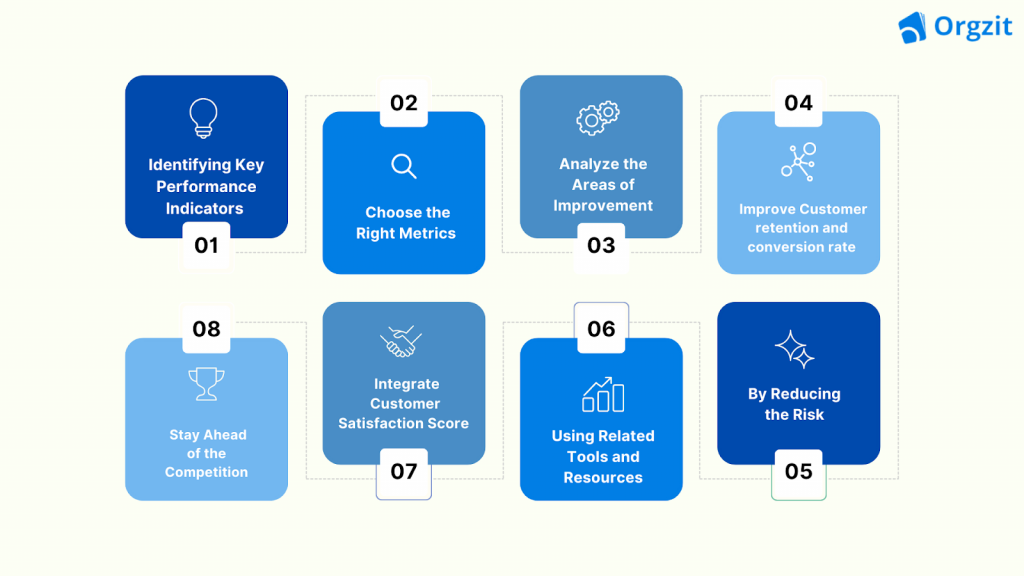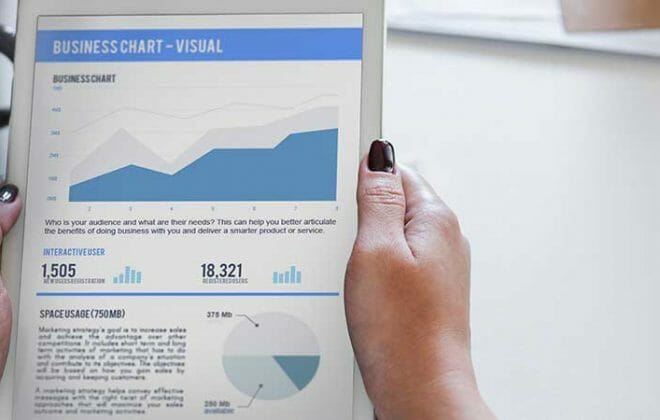Measure your B2B Business Performance Like a Pro in 2023
Don’t you want to know how well your business is performing?
If you are worried that your time and money on marketing and sales initiatives aren’t working, don’t worry. You’re not alone.
Let us walk you through some key indicators that can help you measure your business performance. These indicators are applicable on all business and industries in some way or the other.
TL;DR
- To measure your B2B business performance, it is important to identify where you need to improve efficiency, increase customer satisfaction, and boost your sales and profits.
- There are so many ways to measure B2B business performance. The best way will depend on your specific business goals and your industry.
- However, there are a few key metrics that all B2B businesses should track: sales, marketing and financial metrics. Read more about them in the article.
- Cost per lead (CPL)
- Number of leads generated
- Website Traffic
- Conversion rate
- Revenue growth
- Average sales cycle length
- Win rate
- Churn rate
- Time to Market
- Pro Tips: Choose the right metrics, track them over time, identify problem areas and improve by strategizing. For example, if you notice that your churn rate is increasing, you need to investigate why and develop strategies to reduce it.
- Customer retention and conversion rate are two of the most important metrics for B2B businesses. By focusing on these metrics, you can significantly impact your bottom line.
What is the B2B business process?


B2B businesses sell their products or services to other businesses rather than individual customers. The buying process is often more complex and involves multiple decision-makers.
B2B businesses also need to build strong customer relationships.
The B2B process involves Sales, Operations, and Services, where….
✅Sales operation involves;
- Lead generation: To Identify and qualify potential customers.
- Nurturing: To build relationships with potential customers and tell them about your products or services.
- Closing: Converting potential customers into paying customers for your business with competitive quotes, computing margins and managing bids efficiently.
- Retention: To maintain relationships with existing customers and encourage them to continue doing business with you and make more revenue for your business.
✅Operation process involves;
- Invoicing/ Billing and Account Keeping: To track and manage customer accounts, including invoices, payments, and credit.
- Delivery/Installation Services: To get your products or services to your customers in a timely and efficient manner.
- Dealer/Vendor Management: To manage your relationships with suppliers and other businesses you work with.
- Other: Other operational tasks may include order fulfillment, quality control, and inventory management.
✅Services Involve;
- Customer support: To assist customers with their products or services.
- Technical support: To provide troubleshooting and repair services for technical products.
- Consulting and training: Consulting, training, and other services require specialized expertise.
- Maintenance and repair: Services may include maintenance contracts, managed services, and subscription services.
7 Tips to Measure Your B2B Performance Like a Pro
Here are some tips that will help you to measure your business performance:
Tip 1 Identify Key Performance Indicators
Once you know your goals, you can choose the metrics that will help you track your progress.
It is also important to align your metrics with your sales and marketing funnels. This will help you to identify areas where you need to improve your performance.
Also, you use a variety of metrics to get a complete picture of your business performance. No single metric can tell you everything you need to know.
There are several different ways to measure B2B business performance. The best approach will depend on your specific business goals and the industry you want to operate in.
For measuring business performance, KPIs can help B2B businesses to improve their performance by using different KPIs like:
- Marketing KPIs: To identify the most effective marketing campaigns and adjust them to improve ROI that includes:
- Cost per lead (CPL)
- Number of leads generated
- Website Traffic
- Conversion rate
- Customer acquisition cost (CAC)
- Marketing qualified leads (MQLs)
- Brand awareness
- Social media engagement
- Search engine rankings
- Sales KPIs: To identify areas where the sales process can be improved to increase revenue and profitability, including:
- Revenue growth
- Average sales cycle length
- Win rate
- Churn rate
- Upsell and cross-sell rates
- Customer lifetime value (CLV)
- Customer service KPIs: To identify areas where customer satisfaction can be improved to reduce churn and increase repeat business, includes:
- Customer satisfaction score (CSAT)
- Net promoter score (NPS)
- First response time
- Average resolution time
- Customer churn rate
- Number of customer complaints
- Number of customer compliments
- Product development KPIs: To identify areas where product development can be improved to bring new products to market faster and meet customer needs more effectively, includes:
- Time to market
- Number of new products released
- Product adoption rate
- Customer satisfaction with products
- Number of product bugs
- Number of feature requests
- Customer lifetime value (CLV)
How can a B2B business use KPIs to improve its performance?
Suppose a B2B software company is tracking its conversion rate, which is the percentage of website visitors who sign up for a free trial of its software. The company notices that its conversion rate is only 1%.
The company conducted A/B testing on different landing pages and headlines to improve its conversion rate. After two months of testing, the company found a landing page that converted at 2%, which was a significant improvement.
The company doubled its leads by tracking conversion rates and making data-driven adjustments to its landing page. This means the company is now generating twice as many potential customers, which could significantly increase sales over time.
So, KPIs are essential for any B2B business. By tracking the right KPIs and making adjustments as needed, businesses can identify areas where they can improve efficiency, increase customer satisfaction, and boost their sales and profits.
Tip 2 Analyze the Areas of Improvement


Tracking your metrics timely can identify areas where your business performs well and needs improvement, which helps you to identify the areas where your business is doing well and where it needs to improve.
Imagine a B2B company might track its customer churn rate, which is the percentage of customers that stop doing business with the company over a period of time.
If the company notices that its churn rate is increasing, this could be an indication that there is a problem with its products or services or with its customer service. The company can then investigate the reasons for the increase and develop strategies to reduce it.
Let’s take a live example of how a B2B company can identify its areas of improvement:
A SaaS company tracks its customer churn rate and notices that it has increased from 5% to 7%. The company investigates the reasons for the increase and finds that many customers cancel their subscriptions because they are unsatisfied with the product.
Then, the SaaS company could use a customer survey tool to create a survey to send to its customers. The survey could ask customers about their satisfaction with the product, their reasons for canceling their subscriptions, and any suggestions they have for improvement.
Then, the SaaS company sends the survey to all of its customers or to a targeted group of customers who have recently canceled their subscriptions. Once the company has collected the survey results, it can analyze the data to identify the most common reasons why customers are unsatisfied with the product.
The company then invests more resources to improve the product and customer support.
Tip 3 Improve Customer retention and conversion rate:
“Did you know that a 1% increase in customer retention can lead to a 5% increase in profits? Or that a 2% increase in conversion rates can have the same impact on revenue as a 10% increase in marketing spend?”
- Customer retention rate: This metric measures the percentage of customers who continue to buy from your business over time. A higher customer retention rate means more customers are satisfied with your products or services and are likely to return.
- Conversion rate: This metric measures the percentage of visitors to your website or landing page who take a desired action, such as signing up for a newsletter or purchasing. A higher conversion rate means you are more effective at turning visitors into customers.
Both customer retention and conversion rates are important metrics to track because they can significantly impact your business’s bottom line.
For example, let’s say you have a customer retention rate of 80% and a conversion rate of 2%. This means that for every 100 new customers you acquire, 80 will continue to buy from you in the future, and 2 of them will make a purchase on their first visit.
If you can increase your customer retention rate by 1% and your conversion rate by 1%, you will acquire 100 new customers, 81 of them will continue to buy from you in the future, and 3 of them will make a purchase on their first visit.
This means that a 1% increase in customer retention and a 1% increase in conversion rate could result in a 10% increase in sales.
Tip 4 By Reducing the Risk
By measuring your KPIs, you can identify potential problems and risks early on and take steps to solve them.
While driving a car, if you don’t have a speedometer, you wouldn’t be able to tell how fast you are going. You also risk getting a speeding ticket or having an accident. Similarly, if you dont measure your conversion rate and churn rate you would never know if your business is growing or static or declining.
If you measure your B2B business performance, you can identify potential problems early on. This could lead to serious problems, such as financial losses or bankruptcy.
👉Pro tip: Even small steps can make a big difference.
🔹Set baselines for your metrics. This will give you something to compare your performance against.
🔹Track your metrics regularly. This will help you to identify trends and patterns.
🔹Analyze your data to identify areas where you can improve your performance.
🔹Share your metrics with your team. This will help everyone to stay aligned and focused
on the same goals.
Tip 5 Using Related Tools and Resources
Several tools and resources help you measure your B2B business performance. Some popular options include:
- Choose CRMs with quote management: You can use a CRM with quote management to create and send quotes to your customers and prospects. You can also track the status of your quotes and see when they have been viewed or accepted.
- Bid dashboards: You can also use a bid dashboard to track your pipeline and real-time performance. This information can help you identify improvement areas, such as your bid win rate or the average time to close a deal.
- CRMs with proposal management: You can use a CRM with proposal management to create, track, and send proposals to your customers and prospects. You can also track the status of your proposals and see when they have been viewed or signed.
- Business intelligence (BI) tools: BI tools can help you analyze your data and identify trends and patterns.
- Marketing analytics platforms: Marketing analytics platforms can help you track your marketing performance and identify areas for improvement.
- Customer relationship management (CRM) software: CRM software can help you track customer interactions and relationships, sales pipeline, manage leads, and generate reports.
Tip 6 Integrate Customer Satisfaction Score (CSAT)
Suppose you’re a B2B marketing agency, and your goal is to improve your customer satisfaction.
You want to make your customers happier, so you start tracking how satisfied they are with your products or services (CSAT). You decide to conduct customer survey to learn more about what you can do to improve their happiness. You find that some of your customers want you to respond to their questions faster.
Then you hire a new customer support representative to help you respond to customer questions faster. After a few weeks, you check your CSAT score again and find that it has increased to 90%.
You improved customer satisfaction by measuring your customer satisfaction score and adjusting your customer support process by 10%. This could increase customer retention and referrals, boosting your bottom line.
Measuring business performance can help you identify areas where you can improve efficiency, increase customer satisfaction, and boost your sales and profits.
Tip 7 Stay Ahead of the Competition
You can stay ahead of the competition by measuring business performance and tracking your KPIs.
For example, If you track your sales growth and notice that your competitors are growing faster than you, this could indicate that you need to change your strategy. You can then investigate what your competitors are doing differently and change your strategy to improve your performance.
Here are a few additional points that can keep you ahead of the competition:
- Make sure your metrics are aligned with your goals. It’s important to track the metrics most relevant to your business goals. For example, if your goal is to increase sales, you’ll want to track metrics like conversion rate and customer acquisition cost.
- Automate your data collection whenever possible. This will help you save time and ensure your data is accurate and up-to-date.
- Use a dashboard or reporting tool to visualize your data. This will make it easier to identify trends and patterns.
- Set up alerts to notify you when your performance dips below a certain threshold. This will help you quickly identify and address any problems.
- Regularly review your data and make adjustments to your strategy as needed.
Conclusion
Measuring your B2B business performance is one of the best investments to make your business successful. It is also important to be objective when evaluating your performance. Be bold and identify areas where you can improve. You can identify opportunities to grow and succeed by concluding your business.
By following these tips, you can develop a clarification mindset when measuring your B2B business performance. This will help you to make better decisions and improve your chances of success.


FAQs
B2B business performance measures how well a business is meeting its goals. This can include financial goals, such as revenue and profit, and non-financial goals, such as customer satisfaction and employee engagement.
There are several ways to measure B2B business performance. One key step is identifying the key performance indicators (KPIs) most important to your business. Once you have identified your KPIs, you can start collecting data and tracking your performance over time.
The most important KPIs to track will vary depending on the specific business and its goals. However, some common KPIs that B2B businesses track include:
Revenue
Profit
Customer acquisition cost (CAC)
Customer lifetime value (CLV)
Website Traffic
Lead generation
Conversion rate
Sales cycle length
The frequency with which you track your KPIs will also depend on your specific business and its goals. However, tracking your KPIs every month is generally a good idea. This will give you a good understanding of how your business performs over time.
If you notice that your KPIs need to meet your goals, the first step is to investigate why. Once you have identified the reasons, you can develop strategies to improve your performance.
If your conversion rate is low, you may need to improve your landing pages or test different calls to action. If your customer satisfaction score is low, you may need to improve your customer support or product quality.
Regularly tracking your KPIs and taking action to improve your performance can ensure your B2B business is on track to achieve its goals.









